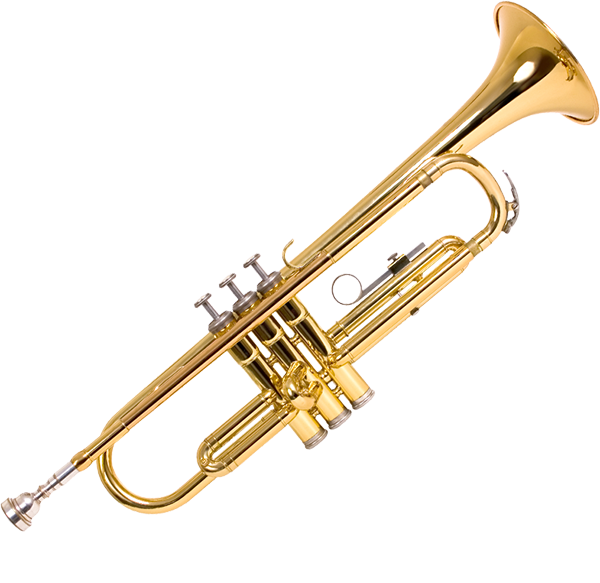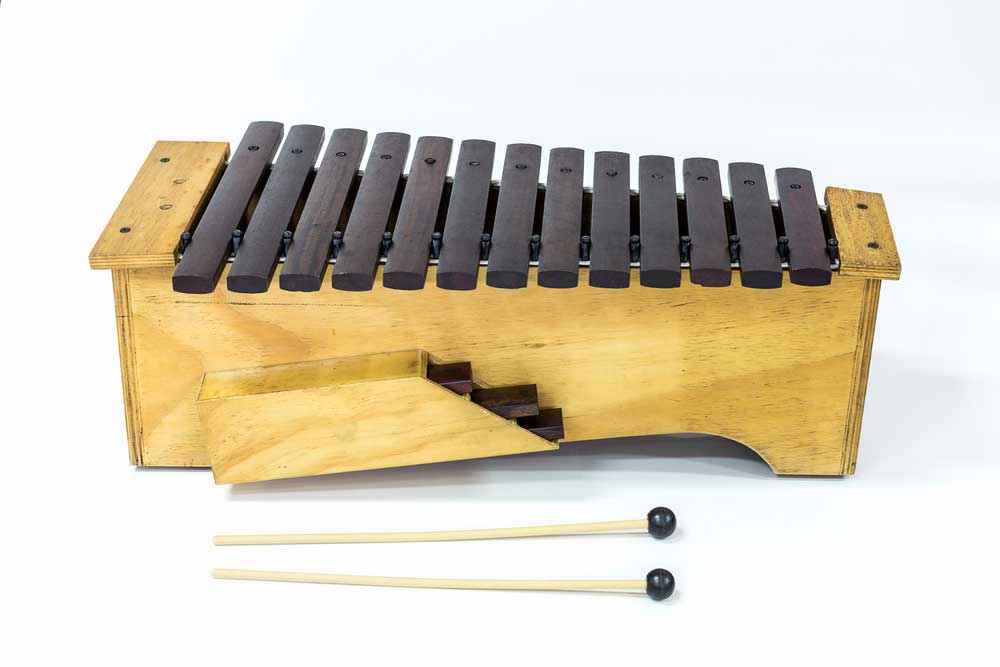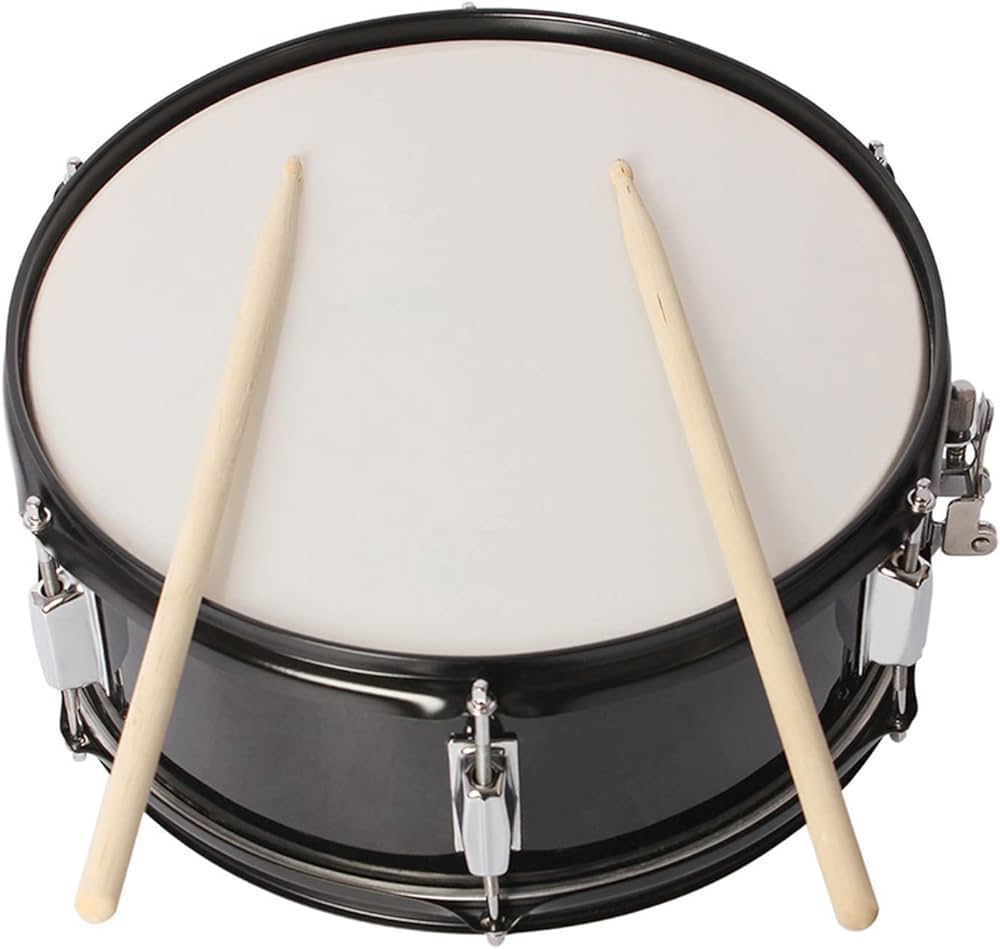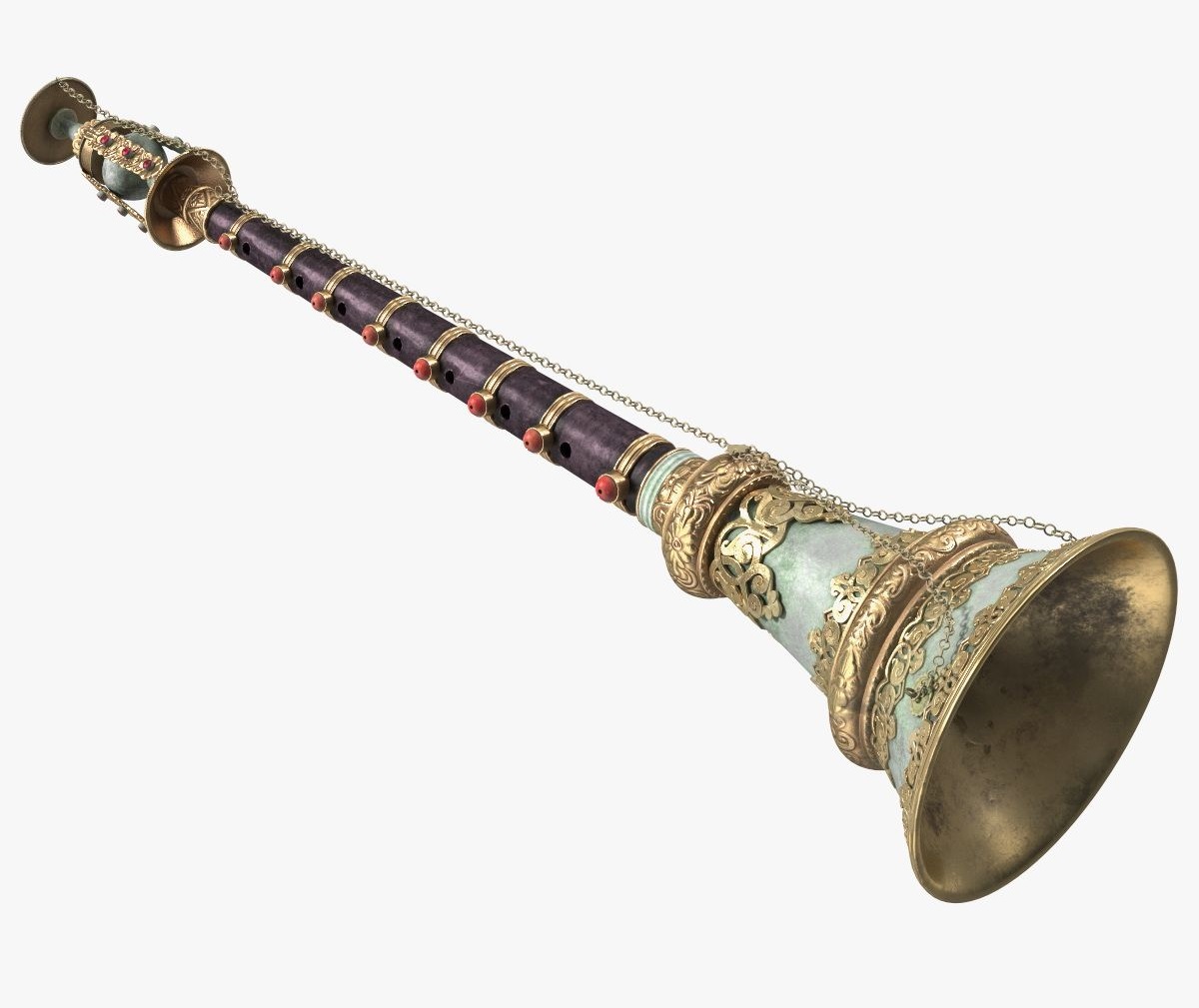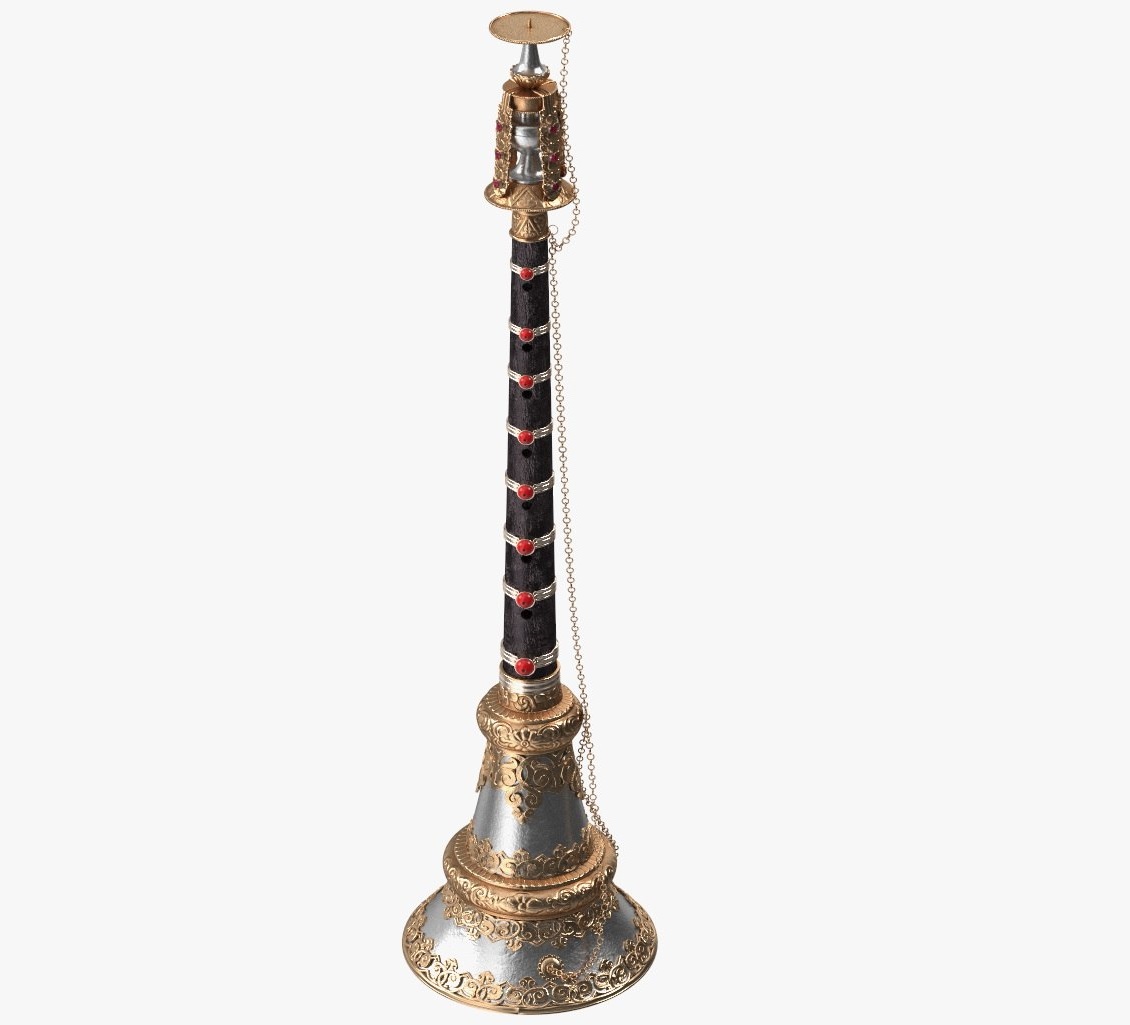Gyaling
Woodwinds
Asia
Between 1001 and 1900 AD
Video
The gyaling, a traditional Tibetan musical instrument, is deeply rooted in the cultural and spiritual practices of Tibet. Its name, which translates to “Indian trumpet,” reflects its historical connection to the Chinese double-reed Suona horn. The gyaling is primarily used in Tibetan Buddhist rituals, particularly during puja (chanting and prayer ceremonies), where it serves as a symbol of devotion and is associated with peaceful deities. As a woodwind instrument, the gyaling produces a distinctive sound that resonates with the spiritual ambiance of monasteries and ritualistic settings. Its sound is often described as piercing yet melodic, capable of evoking a sense of tranquility and reverence.
Type of Instrument
The gyaling belongs to the family of double-reed woodwind instruments, similar to oboes or shawms. Its classification as a double-reed instrument places it alongside other traditional instruments such as the Iranian sorna or Chinese Suona horn. These instruments share common features, including the use of reeds made from marsh grass and a design optimized for producing resonant tones suitable for ceremonial or orchestral settings.
The gyaling’s appearance is oboe-like, with a long hardwood body and an ornate copper-brass bell at its base. The embellishments often include colored glass decorations that enhance its visual appeal, making it not only an auditory tool but also an object of artistic craftsmanship. The eight fingerholes on the instrument allow for varied tonal expressions and intricate melodies during performances.
History
The history of the gyaling spans centuries and is closely tied to Tibetan culture and religion. Originating in Tibet during the 18th century, this instrument reflects influences from neighboring regions such as China and Iran, where similar double-reed instruments were prevalent. Its development coincided with the rise of Tibetan Buddhism as a dominant cultural force, integrating music into spiritual practices. Initially used in military contexts for signaling purposes, the gyaling transitioned into religious ceremonies over time. This shift highlights the adaptability of musical traditions in response to changing cultural dynamics. By adopting a role in Buddhist rituals, the gyaling became an integral part of Tibetan monastic life, contributing to the rich tapestry of Tibetan music.
Tibetan monasteries have preserved the use of gyaling through generations, ensuring its continuity despite external influences or modernization. Monks at monasteries like Key Monastery in India or Tharlam Monastery in Nepal continue to play this instrument during rituals, maintaining its historical legacy.
Construction and Design
The construction of a gyaling involves meticulous craftsmanship to achieve both functional and aesthetic qualities. Its body is typically made from hardwood, providing durability and resonance essential for producing clear tones. The copper-brass bell at its base serves as an amplifier for sound vibrations while adding visual elegance through intricate designs. The double reed is crafted from marsh grass stems, which are carefully shaped to fit into a small metal channel protruding from the top of the instrument. This reed design is crucial for sound production, as it determines tonal quality and responsiveness during play. The reed does not touch the player’s mouth directly; instead, it rests on a flat metal channel below it.
The eight fingerholes on the gyaling allow musicians to manipulate pitch and create complex melodies suited for ritualistic purposes. These holes are strategically placed along the hardwood body to enable precise control over airflow and tonal variations.
Types
While there are no distinct types of gyaling documented historically, variations may exist based on regional craftsmanship or specific ritual requirements. Differences could include variations in size, decorative elements, or minor adjustments in design tailored to individual monasteries’ needs. In some cases, musicians have adapted gyaling techniques for modern instruments like saxophones to replicate its unique sound in contemporary compositions. These adaptations highlight the versatility of gyaling music beyond traditional settings.
Characteristics
The gyaling’s defining characteristics lie in its ability to produce melodic yet piercing sounds that resonate deeply within ceremonial environments. Its tone quality is influenced by factors such as reed construction, airflow control, and player technique. Circular breathing enables continuous sound output essential for maintaining harmony during extended rituals. Ornamentation plays a significant role in gyaling performances, with musicians employing fast neighbor tones reminiscent of bagpipe styles. This approach adds dynamism to its sound profile while preserving traditional melodic structures. Visually, the gyaling stands out due to its ornate embellishments featuring colored glass designs on its copper-brass bell. These decorations reflect Tibetan artistic sensibilities while enhancing the instrument’s ceremonial significance.
In conclusion, the gyaling embodies both musical artistry and spiritual devotion within Tibetan culture. From its historical origins to modern adaptations, this instrument continues to inspire reverence among musicians and audiences alike through its distinctive sound and cultural legacy.
Playing Techniques and Sound Modifications
The gyaling, a traditional Tibetan woodwind instrument, requires a unique playing technique known as circular breathing. This method allows the musician to play continuously without interruption, even while inhaling. The reed, crafted from marsh grass, is fully placed in the player’s mouth but does not touch it directly. Instead, the lips press against a flat metal channel beneath the reed. This setup ensures that airflow, controlled by the musician, determines the tuning and tonal quality of the instrument. It is played with a style reminiscent of bagpipes, employing short and fast neighbor tones. This technique creates a dynamic and vibrant soundscape. Additionally, the instrument’s pitch and timbre can be subtly modified by adjusting airflow and finger placement on its eight fingerholes. Variations in lineage and ritual practices influence specific playing styles, making the gyaling a versatile instrument within its cultural context.
Applications in Music
The gyaling holds a prominent place in Tibetan Buddhist rituals, often performed in pairs as part of an ensemble. It is commonly used alongside instruments such as the dungchen (long horn), kangling (trumpet made from bone or wood), conch shells, handbells (drilbu), and cymbals (silnyen). Together with chanting, these instruments create an atmosphere conducive to spiritual devotion and meditation. Historically, the gyaling also served a signaling function similar to that of a bugle in Western military traditions.
Over time, its role evolved into a spiritual “wake-up call,” symbolizing the summoning of deities during ceremonies. Beyond ritualistic uses, contemporary adaptations have seen the gyaling’s sound incorporated into Western classical compositions and experimental music projects. Its distinctive tone provides an evocative element that bridges traditional Tibetan music with modern interpretations.
Most Influential Players
While individual gyaling players are not widely documented in mainstream music history due to its ritualistic nature, Tibetan monks are considered its most influential practitioners. These monks have preserved and refined the techniques required to play the instrument over centuries. Their performances are integral to monastic ceremonies across Tibet, Nepal, India, and Bhutan. In modern contexts, musicians experimenting with cross-cultural compositions have drawn inspiration from the gyaling’s sound. For instance, ensembles like saxophone quartets have sought to replicate its tonal qualities in their works. These efforts highlight the global appreciation for this unique instrument.
Maintenance and Care
Proper maintenance of the gyaling is essential to preserve its intricate craftsmanship and ensure optimal sound quality. The body of the instrument is typically made from hardwood with a copper or brass bell at its end. Its surface is often adorned with ornate embellishments such as colored glass or intricate carvings, which require gentle cleaning to avoid damage. The reed, being delicate and made from marsh grass, demands special attention. It should be stored in a dry environment to prevent warping or decay. Regular inspection for cracks or wear is necessary to maintain its functionality. Additionally, players must ensure that the metal channel supporting the reed remains clean and free from obstructions.
To prolong its lifespan, it is advisable to store the gyaling in a protective case when not in use. This shields it from environmental factors such as humidity and temperature fluctuations that could affect its structure and sound.
Cultural Significance
The gyaling holds profound cultural significance within Tibetan Buddhism. Its name translates to “Indian trumpet,” reflecting historical influences on Tibetan musical traditions. The instrument is deeply associated with peaceful deities and symbolizes devotion during religious ceremonies. In monastic settings, the gyaling plays a crucial role in creating an auditory environment that facilitates meditation and spiritual connection. Its sound is believed to resonate with divine energies, aiding practitioners in their quest for enlightenment. The use of pairs during performances underscores themes of harmony and balance central to Buddhist philosophy.
Beyond its religious context, the gyaling embodies Tibet’s rich cultural heritage. It serves as a testament to centuries of musical evolution influenced by Indian monastic traditions and West-Asian musical elements. Today, it continues to be a symbol of Tibetan identity both within and beyond the Himalayan region.
In summary, the gyaling is not merely an instrument but a vessel of cultural expression deeply intertwined with Tibetan spirituality and tradition. Its unique soundscape, playing techniques, and symbolic significance make it an enduring icon of both ritualistic devotion and artistic innovation.
FAQ
What is the history of the Gyaling?
The Gyaling is a traditional Tibetan double-reed wind instrument used in Buddhist rituals. It has origins in India and was introduced to Tibet around the 7th century. The instrument is often played in monasteries during ceremonies. Its deep connection to Tibetan culture makes it a sacred musical tool.
What materials are used to construct a Gyaling?
The Gyaling is typically made from wood, often painted or lacquered, with a copper or brass bell. The reed is crafted from cane, similar to an oboe. Some designs feature intricate metalwork or engravings. These materials contribute to its distinct resonant sound.
How is the Gyaling played and used in music?
The Gyaling is played using circular breathing to produce a continuous tone. Musicians use finger holes to change pitch, similar to an oboe. It is primarily used in Buddhist temples for religious ceremonies. The sound is rich, expressive, and often accompanies chanting or meditative practices.
 Links
Links
References
Other Instrument
Categories

